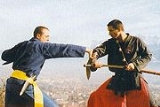
Banshay
Encyclopedia

Indian martial arts
The Indian subcontinent is home to a variety of fighting styles. In Sanskrit they may be collectively referred to as ' or '. The former is a compound of the words and , meaning "knowledge of the sword" or "knowledge of weaponry"...
, it is also closely related to krabi krabong
Krabi Krabong
Krabi krabong is a weapon-based martial art from Thailand. It is closely related to other Southeast Asian fighting styles such as Indonesian-Malay silat, Burmese banshay and the armed component of Cambodian bokator...
and thang-ta
Thang-Ta
Thang-ta or huyen lallong is a weapon-based Indian martial art created by the Meitei of Manipur. In the Manipuri language, thang means sword and ta means spear. As its name implies, the sword and spear are the primary weapons in thang-ta. The spear can be used in its non-missile form while in close...
.
As with similar styles from Thailand
Thailand
Thailand , officially the Kingdom of Thailand , formerly known as Siam , is a country located at the centre of the Indochina peninsula and Southeast Asia. It is bordered to the north by Burma and Laos, to the east by Laos and Cambodia, to the south by the Gulf of Thailand and Malaysia, and to the...
and India
India
India , officially the Republic of India , is a country in South Asia. It is the seventh-largest country by geographical area, the second-most populous country with over 1.2 billion people, and the most populous democracy in the world...
, banshay makes extensive use of the dha (sword)
Dha (sword)
Dha is the Burmese word for "knife." The term dha is conventionally used refer to a wide variety of knives and swords used by many people across Indochina, especially present-day Myanmar , Thailand, Yunnan, Laos, Cambodia and Vietnam.-Origins:The broad use and diffusion of the dha across Southeast...
in pairs. Sword-fencing demonstrations and performances often begin with a pre-fight war dance in which the swordsman spins one or two swords very close to the body without cutting themselves.
Sword training is conducted with the weapon still sheathed. Traditionally when a master first presents the student with a sword, the scabbard would be fixed on so that the trainee is discouraged from killing opponents. Under extreme conditions when the sword must be unsheathed, the scabbard may be broken with a rock or other object.
Internal links
- Burmese martial arts or Thaing (burmese)
- BandoBandoBando is a defensive style of thaing focusing on animal-based techniques. The earliest meanings of the word were self-discipline, self-development and self-improvement. Later, it came to mean self-protection or self-defense...
- LethweiLethweiLethwei is an unarmed Burmese martial art. It is similar to related styles of Indochinese kickboxing, namely Muay Thai from Thailand, pradal serey from Cambodia, Muay Lao from Laos and tomoi from Malaysia.- History :...
- NabanNabanNaban is a style of wrestling from Myanmar. Related to Tibetan and Cambodian grappling arts, naban was originally based on Indian wrestling. It became popular in rural areas where it was often performed at festivals alongside lethwei matches. Naban is most commonly practiced by the tribal peoples...
- Pongyi thaingPongyi thaingPongyi thaing is a Burmese martial art created by the monk Oopali in the 9th century. Based on the Hindu-Buddhist principle of non-violence and non-aggression, its objective is not to cause maximum harm but simply to defend oneself...

